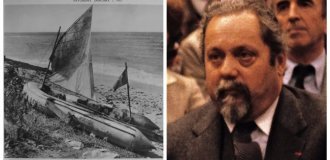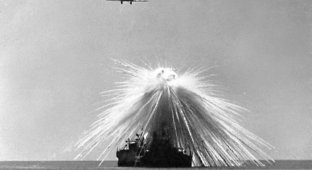When they say that World War II was a war of engines, they remember, first of all, tanks and airplanes. However, the largest number of engines in the armies of the fighting states drove cars, of which, in turn, the bulk were trucks.
Even in the Red Army rifle division, according to the pre-war state of April 5, 1941, there should have been 558 different vehicles. The saturation of tank and mechanized formations with automobile equipment was even greater.
During the interwar period, the armies of most states were content with ordinary “civilian” trucks, at best slightly modified for military needs. However, it was obvious that during the war, trucks would not only travel on good roads. The fighting armies needed reliable, high-quality and unpretentious vehicles with the highest possible cross-country ability. However, the scale of the war and the ever-increasing need for trucks gave rise to another requirement, which often contradicted the previous ones - a wartime vehicle in a warring country had to also be cheap. The designers solved this problem by simplifying pre-war models as much as possible and “throwing away » everything from cars that you can somehow do without, including one or even both headlights and windshield wipers.

Ursus A, Poland.
Produced since 1928. Between 800 and 1,200 vehicles were produced, including 375 for the Polish army. Wheel formula 4?2, weight 2.5 tons, engine 35 hp. Speed up to 60 km/h. Load capacity up to 2 tons

Opel Blitz, Germany.
The first generation of this model, which took part in World War II, was produced from 1930 to 1954. During this time, more than 82 thousand cars were produced. Wheel arrangement 4?2 and 4?4, weight 2.5 tons, engine 54–75 hp. Speed up to 90 km/h. Load capacity up to 3.5 tons

B?ssing-NAG G31, Germany.
Produced from 1931 to 1935. About 2,600 vehicles were built. Wheel formula 6?4, weight 1.5 tons, engine 65 hp. Speed up to 60 km/h. Load capacity up to 1.5 tons

ZIS-5 (“Zakhar Ivanovich”, “three-ton”), USSR.
Produced from 1933 to 1948. At the automobile plant alone. Stalin in Moscow during this time more than 570 thousand ZIS-5 and ZIS-5V vehicles were produced. It was also produced at the Ulyanovsk and Ural automobile plants. Wheel formula 4?2, weight 3.1 tons, engine 73 hp. Speed up to 60 km/h. Load capacity up to 3 tons

A fuel tanker based on a ZIS-6 truck refuels a DB-3 bomber.
The ZIS-6 was produced since 1933, until the fall of 1941, 21,239 vehicles were produced. Wheel formula 6?4, weight 4.2 tons, engine 73 hp. Speed up to 55 km/h. Load capacity up to 4 tons

GAZ-AAA, USSR.
From 1934 to 1943, about 37 thousand trucks and vehicles based on them were produced (including 3331 armored vehicles). Wheel arrangement 6?4, weight 2.5 tons, engine 40–50 hp. Speed up to 72 km/h. Load capacity up to 2 tons

Polski Fiat 621 L, Poland (reconstruction pictured).
From 1935 to 1939, about 13 thousand cars were built. Wheel formula 4?2, weight 2.4 tons, engine 56 hp. Speed up to 55 km/h. Load capacity up to 2.5 tons

Alfa Romeo 500DR, Italy.
In production from 1937 to 1945. Wheel formula 4?2, engine 75 hp. Load capacity up to 4.5 tons

B?ssing-NAG 500, Germany.
Produced from 1938 to 1941. Wheel formula 4?2, engine 105 hp. Load capacity up to 4.75 tons

GAZ-MM (“lorry”), USSR.
Produced from 1938 to 1949. The photo shows a simplified wartime modification of the GAZ-MM-V with a wooden cabin and one headlight. Wheel formula 4?2, weight 1.8 tons, engine 50 hp. Speed up to 70 km/h. Load capacity 1.5 tons

AEC Matador, UK.
Produced from 1938 to 1953, about 9 thousand cars were built. Wheel formula 4?4, engine 95 hp, weight 7.75 tons. Speed up to 60 km/h

38 M. Botond, Hungary.
Produced from 1938 to 1948, 2,554 vehicles were built. Wheel formula 6?4, engine 65–72 hp. Speed up to 60 km/h. Load capacity 1.5 tons

FIAT 626, Italy.
Produced since 1939. Wheel formula 4?2, engine 65 hp. Speed up to 63 km/h. Load capacity 3 tons

Austin K2/Y, UK.
Medical vehicle based on the Austin K30 truck. Trucks of the Austin K30/K2/K3/K4 family with a 4×2 wheel arrangement and a payload of 1.5 to 3 tons have been produced for the British army since 1939. They were equipped with engines with a power of 60–63 hp.

Bianchi Miles, Italy (photo shows a British soldier capturing the crew of an Italian truck in the Western Desert in June 1942).
From 1939 to 1945, about 10,000 vehicles were built. Wheel formula 4?2, engine 65 hp. Speed up to 64 km/h. Load capacity 3 tons

Bedford QLD, UK.
From 1941 to 1945, 52,247 vehicles were produced. Wheel formula 4?4, engine 72 hp. Speed up to 65 km/h. Load capacity 3 tons

Bedford OYD, UK.
Produced from 1939 to 1945. 72,385 vehicles were built. Wheel formula 4?2, engine 72 hp. Speed up to 65 km/h. Load capacity 3 tons (a shortened version of the Bedford OXD with a load capacity of 1.5 tons was also produced). 1772 Bedfords QLD, OYD and OXD were sent to the USSR (275 of them did not reach...

Studebaker US6, USA.
From 1941 to 1945, more than 200 thousand of these cars were produced, of which about 100 thousand were delivered to the USSR. Wheel formula 6?6 (about 20 thousand cars were produced with the formula 6?4), weight 4.5 tons, engine 95 hp. Speed up to 65 km/h. Manufacturer's recommended load capacity is up to 2.5 tons, but transported up to 5 tons

Chevrolet G506, USA.
Produced from 1940 to 1945. 168,603 vehicles were built, of which from 47,700 to 151,053 (according to various sources) were sent to the USSR. Wheel formula 4?4, engine 83 hp. Speed up to 77 km/h. Load capacity 1.5 tons

Austin K5, UK.
Produced from 1941 to 1945. 12,280 cars were produced. Wheel formula 4?4, weight 3.7 tons, engine 85 hp. Speed up to 65 km/h. Load capacity 3 tons

GMC CCKW, USA.
From 1941 to 1945, 562,750 vehicles were produced, of which about 6,700 were delivered to the USSR. Wheel formula 6?6, engine 91 hp. Speed up to 72 km/h. Load capacity 2.5 tons

Mack NR, USA.
In the photo - he is transporting a camouflaged British tank "Valentine". From 1941 to 1945, 26,965 Mack N-series military trucks were built (including 16,548 NR), of which more than 800 were delivered to the USSR. Wheel formula 6?4, engine 131 hp. Speed up to 70 km/h. Load capacity 10 tons

Fordson WOT6, UK.
Produced since 1941. Wheel formula 4?4, engine 85 hp. Speed up to 70 km/h. Load capacity 3 tons. About 30,000 vehicles of this model were produced (and about 2,500 WOT8 with a shortened wheelbase and a load capacity of 1.5 tons). 868 WOT8 were sent to the USSR, 731 trucks reached the target

Ford G8T (Ford 6), USA.
A commercial truck that ended up in military service almost without modifications. From 1941 to 1945, about 78 thousand vehicles were produced, of which about 61 thousand were delivered in the form of vehicle kits to the USSR. Wheel formula 4?2, engine 90 hp. Speed up to 88 km/h. Load capacity 2 tons

M20 Diamond T, USA.
Used as a tank tractor. From 1940 to 1945, 6,554 trucks were built, of which from 296 to 471 units reached the USSR. Wheel formula 6?4, engine 185 hp. Speed up to 37 km/h. Could pull a trailer weighing up to 50.8 tons























